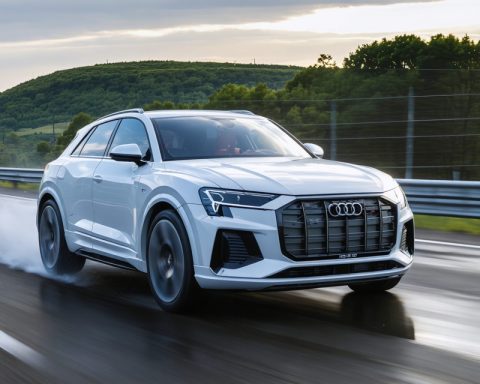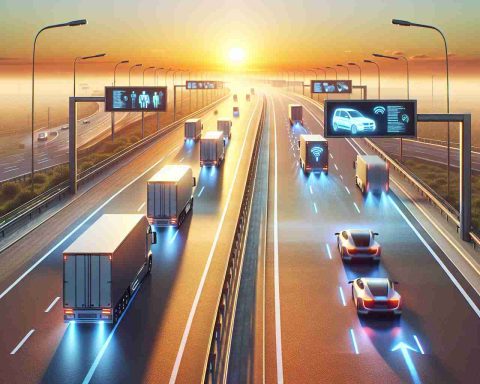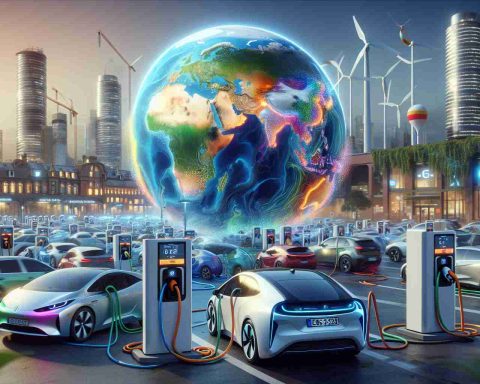- Electric vehicle (EV) sales have surged by 25%, marking a significant global shift towards sustainability.
- China leads the charge with a 37% increase in EV sales, reaching 11 million vehicles in 2024.
- Britain has become Europe’s leading battery-electric market, surpassing Germany.
- EV sales in Europe rose by 0.7% while North America’s sales increased by 8.8%.
- The reduction of German EV subsidies raises concerns about potential impacts on sales momentum in Europe and the U.S.
- EU’s 2025 emission rules present challenges for automakers; carbon credits are vital for meeting targets.
- The shift to electric vehicles promises reduced pollution and healthier urban and natural environments.
Witness the electrifying surge of the automotive world as electric vehicle (EV) sales soar to unprecedented heights, painting a vibrant vision of the future. The globe spins closer towards sustainability, with a staggering 25% leap in sales, encompassing sleek full electrics and savvy hybrids. China spearheads this revolution, electrifying the roads with an impressive 37% jump, tallying up to 11 million pristine vehicles in 2024 alone.
Imagine the bustling streets of Britain, now the crown jewel of Europe’s battery-electric market, eclipsing Germany by strategic incentives and ambitious emission targets. While Europe’s numbers skated upwards by a modest 0.7%, North America joined the charge, climbing by 8.8%, presenting a hopeful tableau of change.
However, this electrified avenue isn’t without its potholes. The withdrawal of German subsidies threatened to deflate the continent’s momentum, whispering cautionary tales across the Atlantic. The looming possibility of subsidy cuts in the U.S. casts shadows on future American savings, challenging buyers to act amid the whimsy of legislative winds.
Visionary automakers now face the pressing tick of the European Union’s stringent 2025 emission rules. Here, carbon credits surface as vital lifelines, allowing industries to trade emissions like currency. These tradable permits, shrinking over time, cultivate a new economy where pollution’s price fuels innovation.
As the world pivots away from fossil fuels, the significance of adopting electric vehicles burns bright. Less pollution, fewer spills, and a breathable future beckon. This shift not only rejuvenates our urban landscapes but nurtures the fragile ecosystems that once bore the brunt of industrial ambition. The road is clear, the charge is full, and the future is electric.
The Shocking Future: Why Electric Vehicles Are More Than Just a Trend
How-To Steps & Life Hacks for Adopting Electric Vehicles (EVs)
1. Research and Choose the Right Type of EV: Understand the differences between full electric and hybrid vehicles. Consider your driving habits and charging station availability. Start by examining the leading models from Tesla, Nissan, and Chevrolet.
2. Evaluate Charging Options: Assess where you can charge your vehicle. Home charging stations can be installed with a one-time investment, while public infrastructure is expanding rapidly across urban areas.
3. Explore Incentives and Rebates: Governments often offer various financial incentives. In the U.S., federal tax credits up to $7,500 may be available, depending on the model.
Real-World Use Cases
– Urban Commuters: EVs are perfect for city driving, where travel distances are shorter, and charging stations are available.
– Ride-Sharing Services: Companies like Uber and Lyft are increasingly adopting EVs for lower operational costs.
– Fleet Vehicles: Businesses in delivery and transport services leverage EVs to cut fuel costs and meet sustainability goals.
Market Forecasts & Industry Trends
The EV market is expected to grow significantly, with projections estimating a compound annual growth rate (CAGR) of about 29% through 2030 (source: BloombergNEF). This growth is fueled by a combination of stricter emissions regulations and innovations in battery technology.
Reviews & Comparisons
When comparing top EVs, consider:
– Tesla Model 3: Known for its long range and advanced technology.
– Nissan Leaf: Offers affordability and a strong track record.
– Ford Mustang Mach-E: Stands out for its style and performance.
Controversies & Limitations
– Range Anxiety: One of the primary concerns remains the distance EVs can travel on a single charge.
– Battery Disposal: The question of how to dispose or recycle batteries responsibly is yet to be fully addressed.
Features, Specs & Pricing
– Price Range: EVs typically range from $30,000 to $100,000, depending on the model and features.
– Charging Time: Most home chargers will recharge a vehicle overnight, around 8-10 hours, while rapid chargers at public stations can provide an 80% charge in less than an hour.
Security & Sustainability
EVs contribute to reduced greenhouse gases, with zero tailpipe emissions. Innovations in battery recycling and manufacturing are making the production process more environmentally friendly.
Insights & Predictions
By 2030, EVs could account for over half of all vehicle sales globally, partially driven by China’s aggressive production and adoption strategies.
Tutorials & Compatibility
Many manufacturers offer online tutorials for new EV buyers, covering everything from charging to maximizing battery life. Compatibility with home charging units is generally universal, though adapters are available for different plug types.
Pros & Cons Overview
Pros
– Reduced environmental impact
– Long-term cost savings on fuel
– Lower maintenance requirements
Cons
– Initial higher purchase cost
– Limited range compared to traditional vehicles
– Charging infrastructure still expanding
Actionable Recommendations
– Stay Informed: Regularly check for new government incentives and rebates which can significantly reduce the cost of switching to an EV.
– Test Drive Multiple Models: Experience the differences firsthand to know which one suits your lifestyle.
– Plan for Home Charging: If possible, install a home charging station for convenience and long-term savings.
For more insights on the EV industry and to explore current offerings, visit the main domain for Tesla, Nissan, and Ford.








